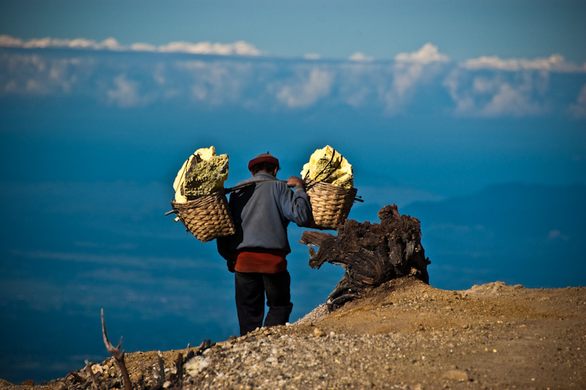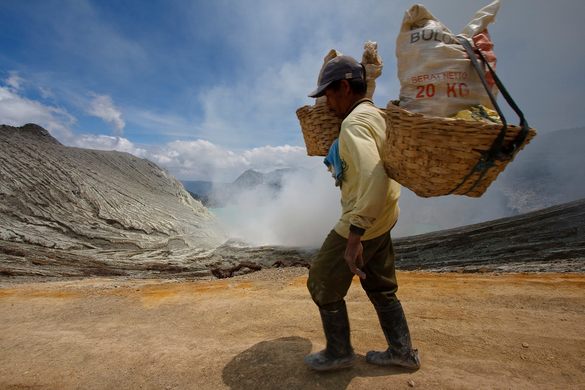Kawah Ijen
Think you have a tough job? Try carrying 200 kilos through a cloud of sulfur down the side of a volcano.
It is an American pastime to complain about one’s job. A bad boss, late hours, poor pay; there is always plenty to complain about. However even the worst office 9-5 in the U.S. is a cakewalk compared to being a sulfur miner on Kawah Ijen, an 8,660-foot active volcano in East Java, Indonesia, which bears a certain similarity to Dante’s vision of hell.
Working on the side of the active volcano in temperatures surpassing 100 degrees Fahrenheit, workers use metal poles to hack out chunks of elemental sulfur. Using ceramic pipes, they channel the gases which drain out as liquid red sulfur which then hardens into the yellow chunks the miners carry out. To do all this, the workers must stand near a live sulfur vent pouring out masses of the noxious, choking gas (the air carries H2SO4 and CaSO4, which are both toxic). The workers then load baskets with 150-200 pounds (68-91 kilos) of sulfur chunks and haul them up 200 meters to the crater rim, and then down three kilometers of traile and 1500 meters of elevation to the weighing station where the sulfur is sold to be used in vulcanizing rubber and bleaching sugar. The reward: around US$13 a day.
One of the problems with improving the men’s situation is that they are all essentially freelance, with no direct employer, so the only safety standards are those the men impose on themselves, which are very few. The men generally work without (expensive) gas masks, despite the fact that prolonged exposure to the noxious fumes can cause respiratory problems similar to severe asthma. And that’s not to mention the sheer backbreaking nature of the work. One reason the men work in the mine, despite having a life expectancy of about 30, is that it pays marginally better than being a farmer.
There is a nearby crater lake, which from afar looks like it might be nice for a cool dip after a hard day of mining, but one would be seriously mistaken. The lake is a 90-degree pool of sulfuric acid in which nothing lives, and which would kill any that dared to swim in it. Birds have been reported to drop dead from the lake’s fumes and to fall into it if they fly overhead. There is no respite to be taken in the harsh volcanic world of Kawah Ijen.
Paradoxically, the unusually high sulfur concentrations that feed Kawah Ijen’s mining industry also result in brilliant blue flames that erupt from the volcano and flow lava-like down the mountain. The spectacular display, visible most nights, occurs when the volcano’s sulfuric gases reach the surface and ignite. Burning liquid sulfur creates the appearance of blue lava streaming down the mountainside. From a distance, Kawah Ijen appears not as an unforgiving workplace but as one more of nature’s odd and beautiful phenomena.
Know Before You Go
The nearest airport is the Banyuwangi airport with limited flights from Jakarta or Surabaya. From the airport, it's a 2-hour drive. For visitors from Bali, fast boat operates from Jimbaran Bali to Boom Beach in Banyuwangi taking approximately 2-hours. From Banyuwangi, you can choose from all kinds of vehicles such as 4WD or motorbike or car to get to the starting point of the hike up to Ijen Crater.Alternatively, you can go via Bondowoso from either the northern or southern coast. This is the closer but steeper way and would require a 4WD to access. After that, you will walk for another 8km to Pos Paltuding, the starting point of the hike to Ijen Crater. The cost and difficulty of this route make it the less popular way.






































Follow us on Twitter to get the latest on the world's hidden wonders.
Like us on Facebook to get the latest on the world's hidden wonders.
Follow us on Twitter Like us on Facebook